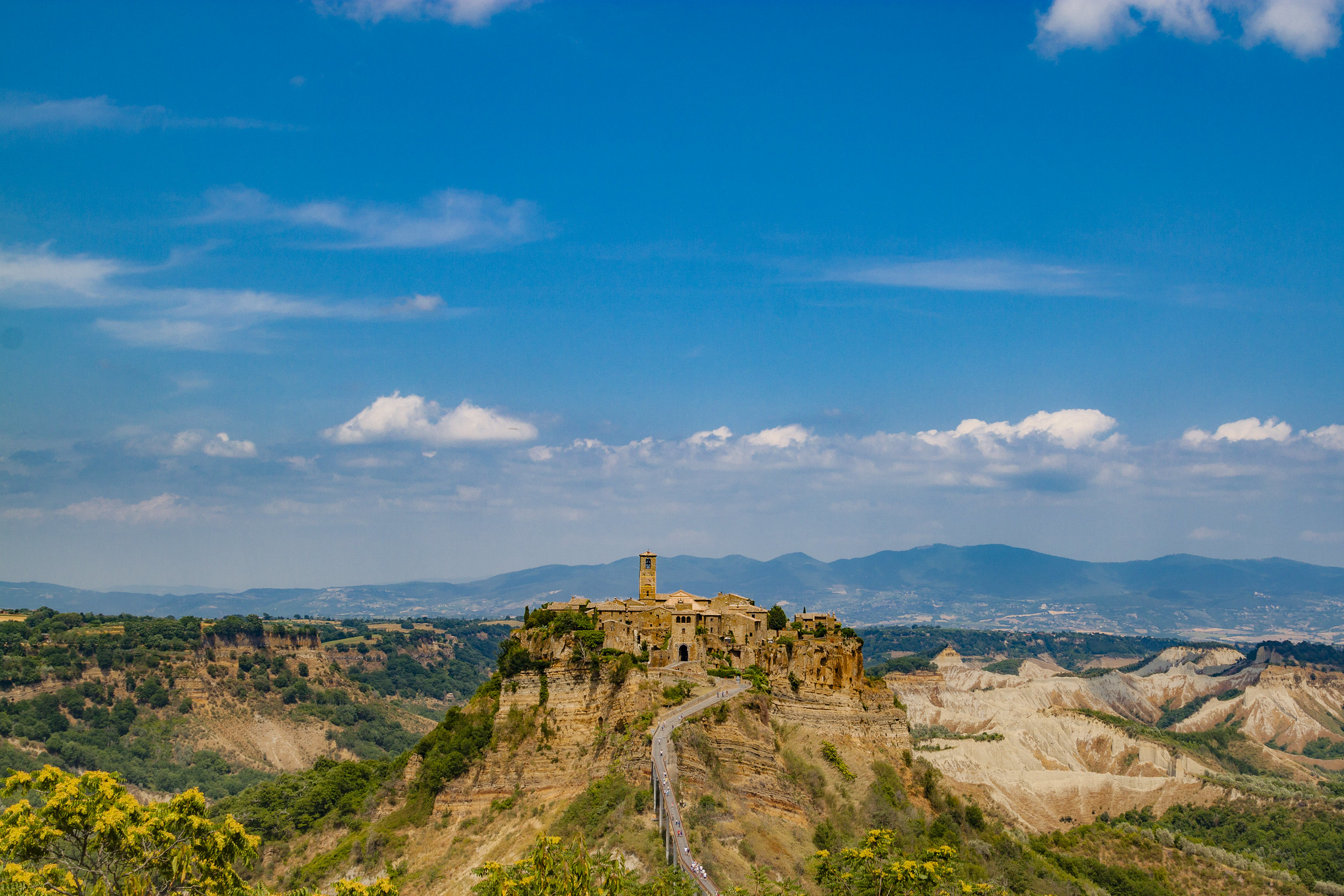
CIVITA DI BAGNOREGIO.
The charming medieval village, known worldwide as “the dying city” due to the gradual collapse of the perimeter walls and the subsequent abandonment by the population over the past few centuries-now numbering only sixteen inhabitants-gives a truly unforgettable and surreal atmosphere.
In fact, the city has had problems with erosion of the rock on which it is built since the time of the Roman Empire; for more than 2,500 years the rock has suffered continuous subsidence, resulting in the characteristic “gullies.”
Gullies are in fact special types of soil erosion that are created by weathering, particularly by rainwater.
They are formed mainly in clay soils; this is a very special soil in which several layers of limestone, clays
sandy and residues from the eruptive action of the nearby Volsini Mountains complex.
Precisely because of this particular nature, the territory of the Valley of the Badlands is characterized by erosive phenomena that give rise to real cuts in the ridges of the heights, totally barren because they are affected by continuous erosion.
The current appearance of the village dates back to the late Middle Ages and has remained almost intact since then, giving it the fascinating aura of a place where time has stood still. As one crosses the bridge, one can admire the spectacular landscape of this area of upper Lazio, a panorama of valleys and gullies carved by millennia of water erosion, and then on to Porta Santa Maria.
In 1695, an earthquake, adding to the destructive work of erosion, brought extensive damage to the town of Civita. In1794, a second earthquake collapsed the narrow natural bridge connecting Civita to the outer village of Rota.
Most of the inhabitants abandoned the hill and settled in Rota, the district that arose in the 13th century and now forms the historic center of
Bagnoregio.
The ancient settlement of Civita was accessed through five gates, while today the gate known as the Santa Maria or della Cava gate represents the main one.In addition, it is possible to access Civita from the valley of the gullies through a tunnel dug into the rock, known as the Bucaione.
A number of medieval houses remain in the village, as well as the church of San Donato, which overlooks the main square and inside which is housed the 15th-century wooden S.S. Crucifix by the school of Donatello, and a fresco by the school of Perugino. Alemanni Palace, home of the Geological and Landslide Museum, the Bishop’s Palace, a 16th-century mill, the remains of St. Bonaventure’s birthplace, and the gate of Santa Maria, with two lions holding a human head between their paws, commemorating a popular revolt by the inhabitants of Civita against the Orvietan Monaldeschi family. To access the Civita center, visitors must pay a small entrance fee ) which allows the municipal administration to carry out restoration and stabilization work and keep the village visitable.
EVENTS
At Christmas time, a living nativity scene is held there; The events of Mary and
Joseph are set in medieval streets.
- The first Sunday in June and the second Sunday in September is set up.
in the main square the centuries-old Palio della Tonna (“round” in the local dialect), in which the districts of Civita compete on the back of a donkey, supported by the cheering of the inhabitants. - On the first Sunday in June there is the first patron saint‘s festival, known as Mary’s
SS. Liberator. - The last week of July and the first week of August, Tuscia in Jazz is held.
Festival with concerts, seminars and jam sessions. - On the second Sunday in September, the second patronal festival is held,
called the Holy Crucifix.
WHERE TO EAT.
Alma Civita Restaurant
Via della Provvidenza, snc | Tel +39 0761.79.24.15
is a restaurant and accommodation facility located in the heart of the village of Viterbo, inside a restored old mansion. Both pasta and desserts are homemade, and you will find a long list of soups with seasonal ingredients (such as lentil and dried fig, chickpea and chestnut, mushroom, borage, etc.).
Hosteria al Forno di Agnese
Via S. Maria Del Cassero, 38 | Tel. +39 0761.79.25.71
It offers typical dishes by revisiting them, giving them a special touch, without ever neglecting the authenticity of the products consumed. With outdoor hall under a beautiful pergola.
The Wishing Well
It is a tavern located almost at the entrance to the village, to the left of the archway that the many tourists pass through to access it. Everything is superbly cared for, starting with the exterior decorated and enriched with colorful flowers, now occupying the place of what was a cistern in Etruscan times.The products offered are all strictly zero kilometer, from the Rocchi farm and other producers in the Viterbo area. Among the offerings are charcuterie boards and selection of Tuscia cheeses.
Bar Enoteca “La Piazzetta”
It is located in one of the most picturesque corners of the entire village, the “Garden of Poets,” which offers a breathtaking view of the surrounding landscape, dominated by the clear tuffaceous rocks.Possibility of also choosing the aperitif formula, or the sandwich and glass of wine option, as well as tasting excellent soups (such as chickpea or mushroom soup). Organic products can also be purchased inside.


